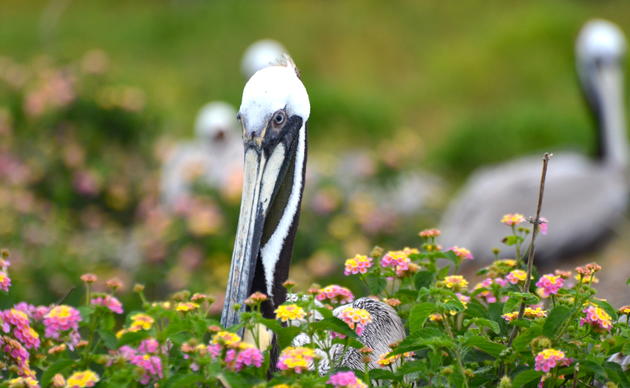Black Skimmer
The large red and black bill of the Black Skimmer sets it apart from other American birds. The lower mandible of the bill is longer than the upper mandible. As they fly over the water, Skimmers drag their bills through the water, hoping to catch small fish.
The majority of Black Skimmer colonies can be found along the along the central and upper Texas coast; up to 25% of the total state population nests on islands in Galveston Bay. Colony sites include barrier beaches, dredge spoil islands, shell banks, spoil islands and salt marshes that are sparsely vegetated (<20% cover) with open sandy and/ or shelly areas. Vegetation cover is vital to colony site selection, skimmers tend to occupy areas with up to 10% vegetation and will actively avoid areas with >30% cover.
Throughout most of their range, Black Skimmers nest in colonies with various tern species, deriving some protection from these more aggressive neighbors. The species is becoming more prone to washouts as prime, higher elevation nesting locations are taken over by development and recreational pressures. The presence of a gull colony on higher beaches will also discourage nesting by skimmers and terns. Skimmers usually abandon unsuccessful colony sites but will continue use of successful sites. Foraging areas are often near the colony site and include tidal waters of bays, estuaries, lagoons, rivers and salt marsh pools, creeks and ditches where small fish are concentrated.
For more information, and tips on how to identify Black Skimmers, visit their page on the Cornell Lab of Ornithology.
Click here to view a graph showing change in Black Skimmer numbers since 1973.
Text References
- King, K. A. 1989. Food Habits and Organochlorine Contaminants in the Diet of Black Skimmers, Galveston Bay, Texas, USA. Colonial Waterbirds:109-112.
- Gochfeld, M. and J. Burger. 1994. Black Skimmer (Rynchops niger).in A. Poole, editor. The Birds of North America Online. Cornell Lab of Ornithology, Ithaca.
- Burger, J. and M. Gochfeld. 1990. The Black Skimmer: social dynamics of a colonial species. Columbia Univ. Press, New York.
- Burger, J. 1982. The role of reproductive success in colony-site selection and abandonment in Black Skimmers. The Auk 99:109-115.
How you can help, right now
Join Audubon Texas Today
Becoming a member supports our local work protecting birds and the places they need.
Consider a Legacy Gift for Texas
Planned gifts and bequests allow you to provide a lasting form of support to Audubon Texas.
Subscribe to Our Newsletter
Subscribe to our newsletter for updates about Audubon Texas's conservation work, and news about our activities and local events.




